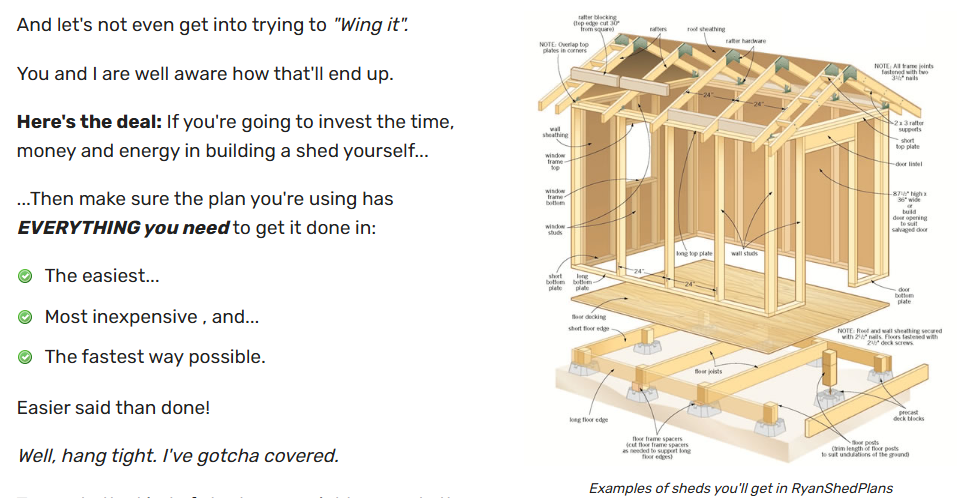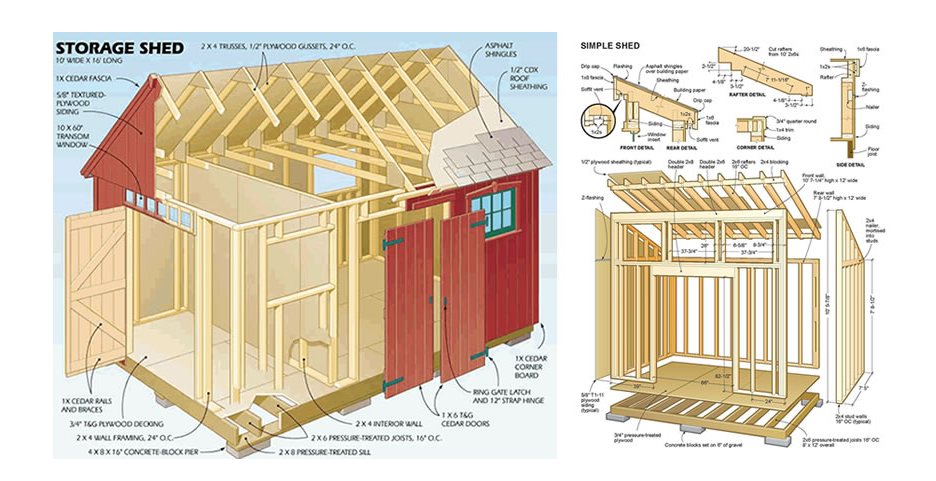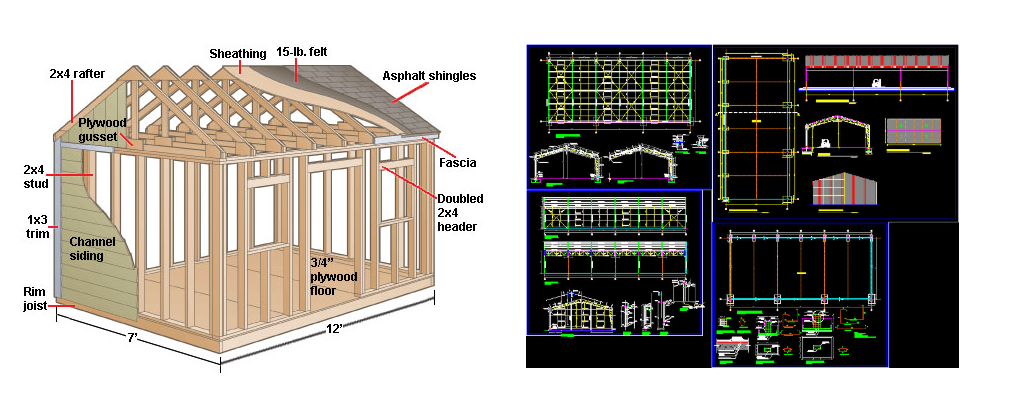Introduction to My Shed Plans
My Shed Plans is a comprehensive resource designed to empower aspiring woodworkers by offering thoughtfully curated woodworking plans tailored for constructing sheds. These plans cater to individuals with varying levels of expertise, ranging from novice builders to seasoned carpenters. The primary goal of My Shed Plans is to simplify the shed construction process, enabling enthusiasts to create their dream sheds efficiently and effectively.

One of the predominant benefits of using My Shed Plans lies in their structured nature. Each plan provides step-by-step instructions, accompanied by detailed diagrams that guide users throughout the construction process. This ensures that even those with little to no prior experience can confidently tackle their projects. Furthermore, the plans include a comprehensive materials list, which makes sourcing necessary supplies straightforward and convenient.

Woodworking, while a rewarding hobby, often presents various challenges. Common hurdles include interpreting complex designs, miscalculating material requirements, and facing construction errors due to inadequate planning. My Shed Plans addresses these issues by providing clear and concise instructions that eliminate ambiguity. By following these plans, users can avoid common pitfalls, thereby reducing frustration and increasing the likelihood of successful outcomes.
The importance of proper planning cannot be overstated in woodworking projects. A well-structured approach helps in time management and resource allocation, ensuring that projects are completed efficiently. Additionally, meticulous planning allows builders to foresee potential challenges and devise effective solutions ahead of time. As a result, using My Shed Plans not only streamlines the process but also enhances the overall experience of building your own shed.
Step-by-Step Plan:What to Expect
When embarking on the journey to construct your dream shed, step-by-step woodworking plans play a pivotal role in ensuring a smooth and successful building experience. My Shed Plans offer comprehensive and meticulously designed plans that break down the entire process into manageable segments. These plans cater to both novice and experienced woodworkers, providing them with a structured approach to shed building.


One of the essential components of these woodworking plans is the inclusion of clear instructions. Each step is articulated with precision, guiding the builder through every phase of construction. This clarity minimizes confusion and errors, allowing individuals to follow along seamlessly. Whether it involves measuring dimensions, cutting wood pieces, or assembling components, the instructions are designed to facilitate a logical progression from one task to the next.
Additionally, the material lists provided in the plans are extensive and detailed, ensuring that builders are well-prepared before they commence work. These lists outline all the necessary supplies, including types of wood, hardware, and finishing materials. By having a comprehensive overview of what is needed, builders can make informed purchasing decisions, ultimately saving time and resources during the construction process.

Another important aspect of the plans is the inclusion of diagrams. Visual aids significantly enhance the understanding and application of the instructions. The diagrams serve as a helpful reference, illustrating each step and providing a visual representation of how components fit together. This aspect is particularly beneficial when dealing with complex structures or configurations, as it aids builders in grasping the spatial relationships and assembly methods.
By utilizing the step-by-step woodworking plans offered by My Shed Plans, individuals can confidently approach their shed-building projects. The combination of clear instructions, detailed material lists, and helpful diagrams ensures that builders can navigate the process effectively, leading to successful outcomes.
Common Mistakes to Avoid in Shed Construction
Building a shed can be a fulfilling project for any woodworking enthusiast, yet it is essential to be aware of common mistakes that can hinder the construction process. One prevalent error is miscalculating materials. Accurate measurements are fundamental to any woodworking project. Builders might underestimate the quantity of wood or other materials required, leading to delays and increased costs when additional supplies need to be purchased mid-project. To prevent this, always create a detailed list of materials based on measurements taken directly from the site.

Another frequent pitfall is improper tool usage. Many novices may lack sufficient knowledge about how to use power tools safely and effectively. This not only poses a risk of injury but can also lead to poorly constructed components that fail to fit together properly. Before beginning your shed project, take the time to familiarize yourself with all necessary tools and ensure that you understand their operation. If you’re unsure, consulting manuals or watching instructional videos can be tremendously helpful.

Inadequate preparation is yet another common mistake that can derail the construction process. For instance, failing to establish a solid foundation or neglecting to account for local weather conditions can lead to structural issues. It is vital to choose an appropriate location for your shed and ensure that the area is level and well-drained. Additionally, consider the surrounding environment and how it may impact your project over time.
By being aware of these common pitfalls—miscalculating materials, improper tool usage, and inadequate preparation—builders can navigate their shed construction with greater confidence. Avoiding these errors not only saves time and resources but also enhances the overall quality of the final product.
Ultimate Tips for a Successful Shed Build
Embarking on a shed-building project can be both exciting and daunting. To ensure a successful outcome, begin by selecting the right materials. Quality lumber, durable roofing, and weather-resistant fittings not only increase the longevity of your shed but also enhance its aesthetic appeal. When choosing wood, consider local climate conditions; for instance, treated lumber is ideal for areas with high moisture levels, while untreated wood might suffice in drier regions.

Building your shed requires careful planning, so take the time to draft a comprehensive set of woodworking plans. These plans should include dimensions, a materials list, and step-by-step instructions. Break down the project into manageable tasks to prevent feelings of being overwhelmed. This helps maintain your motivation and keeps the project moving forward smoothly.
Consider investing in quality tools. Using the right equipment can significantly affect the efficiency and quality of your workmanship. Essential tools typically include a circular saw, a drill, a level, and clamps, among others. Furthermore, ensure you know how to use them safely and effectively. Regularly maintaining your tools will also contribute to a smoother building process.

Additionally, create a dedicated workspace. This not only helps in organizing tools and materials but also fosters a productive mindset. Make sure your workspace is well-lit and adequately ventilated to ensure safety and comfort while working.
Staying motivated throughout the project can be challenging, especially if unforeseen difficulties arise. To combat this, set small, achievable goals and celebrate milestones. Joining a woodworking community can provide support, inspiration, and encouragement, as well as opportunities to share your progress and learn from others’ experiences.

By implementing these tips, you will enhance your shed-building experience and move closer to creating a finished product that meets your vision and needs.


